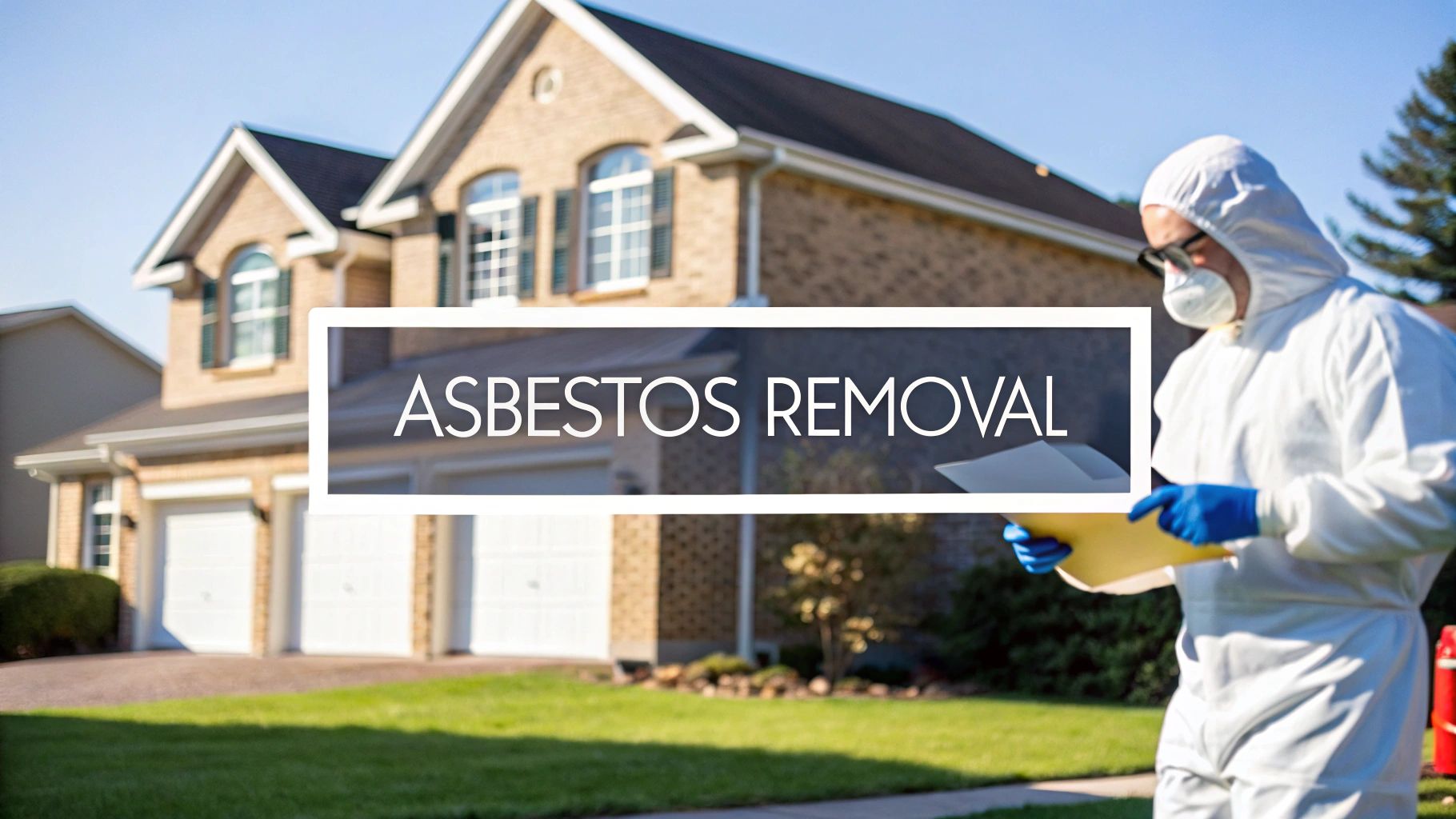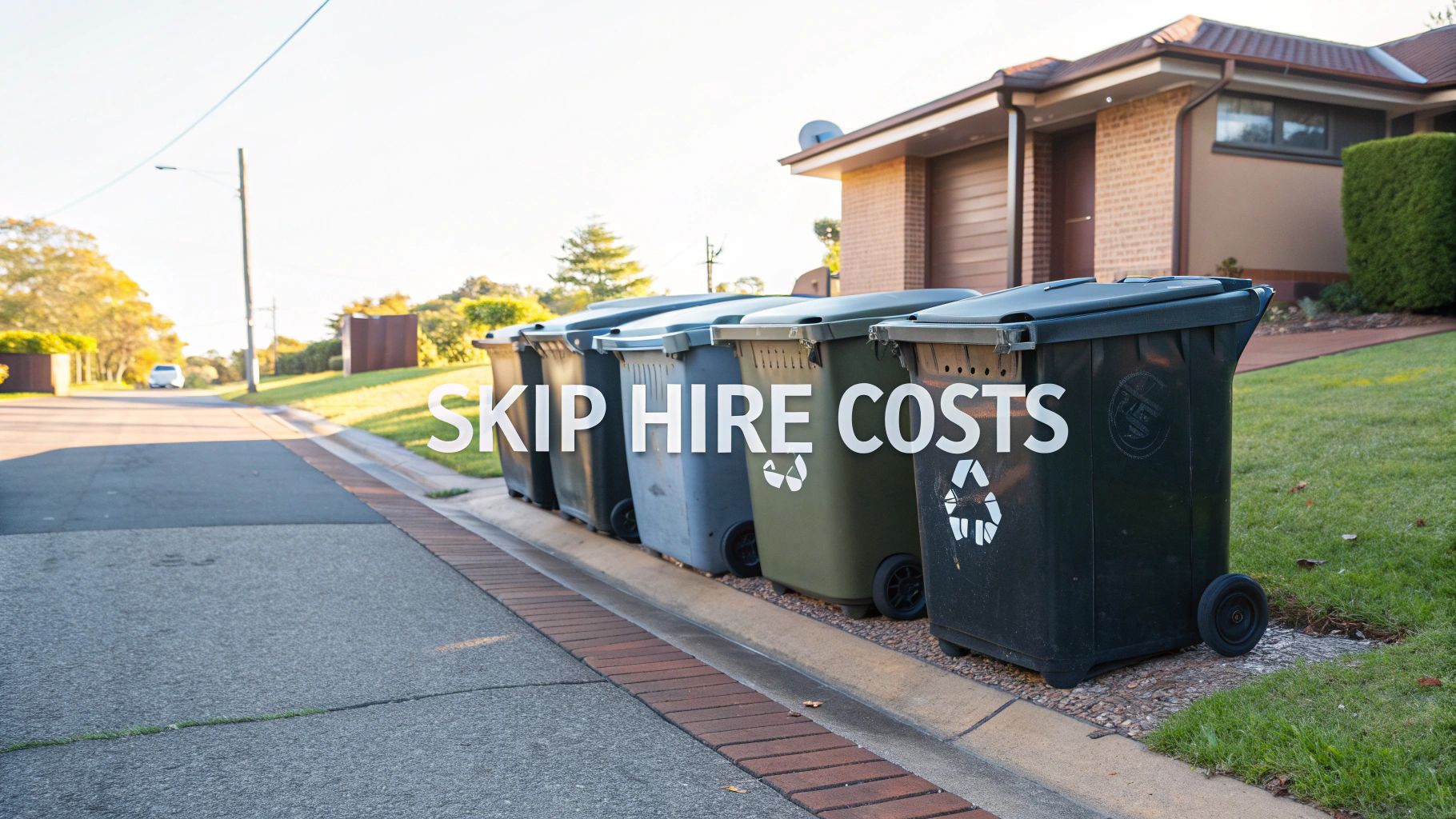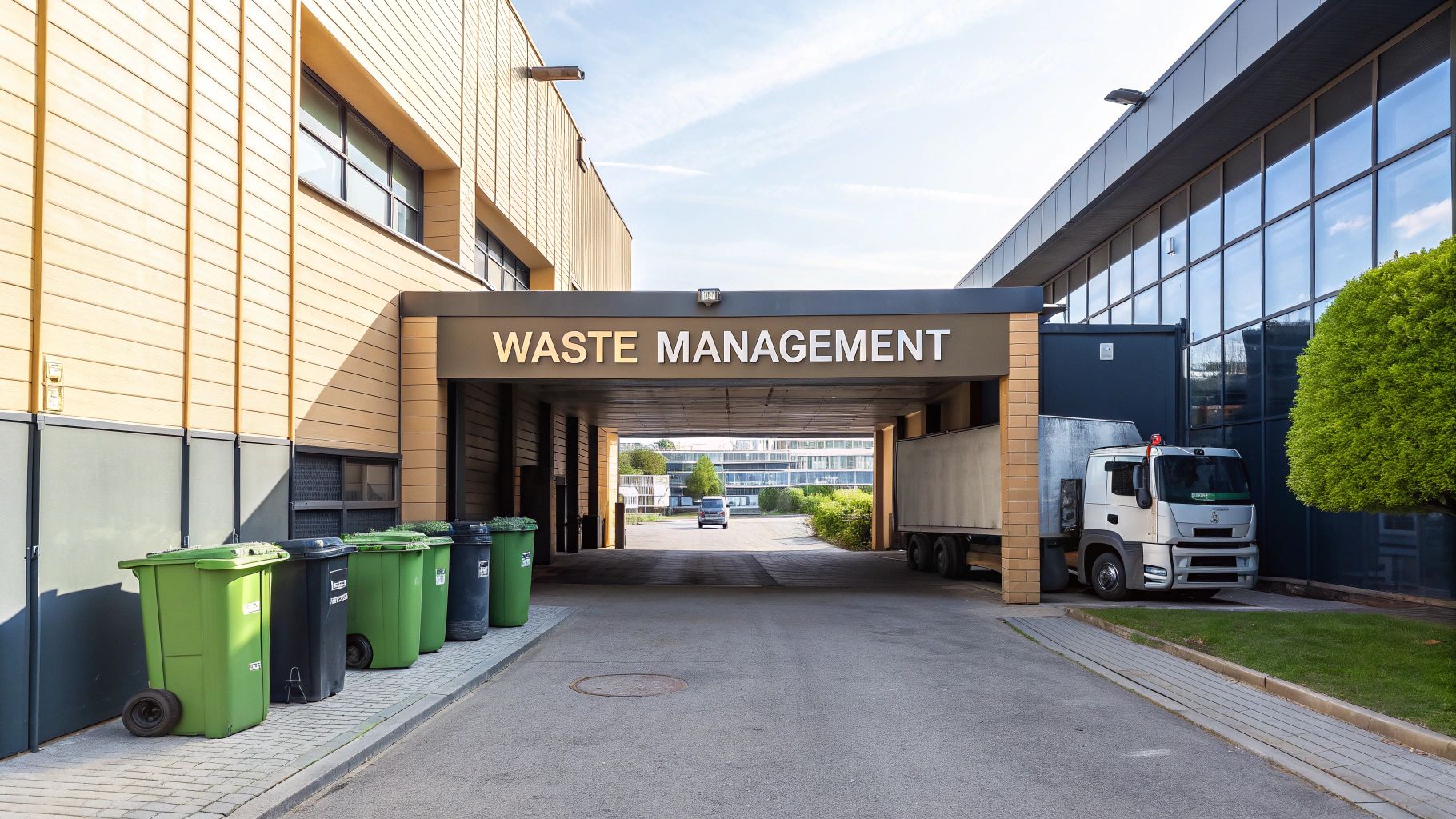A Practical Guide to Type 1 Aggregate
A Practical Guide to Type 1 Aggregate
If you’ve ever wondered what goes under a new driveway, patio, or even a main road, the answer is almost always Type 1 aggregate. It’s the unsung hero of countless construction projects, providing the solid, reliable foundation that everything else is built upon.
The Foundation of Strong Construction

Think of building a solid foundation a bit like solving a jigsaw puzzle. You can’t just throw random pieces into the box and hope they hold together; you need the right pieces designed to interlock perfectly, creating a single, strong structure. This is exactly what Type 1 aggregate does.
It isn’t just a pile of leftover stones. It’s a carefully engineered mix of crushed rock, usually limestone or granite, containing a precise range of particle sizes. You get everything from larger 40mm stones right down to fine, sand-like dust.
When this mixture is spread out and compacted, something brilliant happens. The larger stones create the main load-bearing structure, while all the smaller pieces and dust work their way into the gaps, filling every void. This creates an incredibly dense, tightly interlocked layer that distributes weight evenly and resists movement.
Without this, any surface laid on top would quickly fail. Patios would sink, driveways would develop ruts, and roads would crack under pressure. It’s the quality of this sub-base that guarantees a long-lasting finish.
For a quick overview, here are the key details in one place:
Type 1 Aggregate at a Glance
| Characteristic | Description |
|---|---|
| Material Composition | A mix of crushed stone (typically granite or limestone) with a specific particle size distribution. |
| Particle Size Range | Varies from 40mm down to fine granular dust. |
| Key Property | Excellent load-bearing and compaction qualities, forming a dense and interlocking sub-base. |
| Primary Use | Creating stable foundations for driveways, patios, paths, roads, and building bases. |
| Certification | Often referred to as MOT Type 1, meeting standards set by the Department for Transport. |
| Installation Method | Spread in layers and compacted with a whacker plate or roller to achieve maximum density. |
This table summarises why Type 1 is the go-to choice for creating strong, durable foundations in so many different projects.
Understanding MOT Type 1
You’ll often see this material sold as MOT Type 1. This isn’t just a brand name; it's a mark of quality that tells you the aggregate meets a specific standard.
The "MOT" stands for the old Ministry of Transport (which is now part of the Department for Transport). They were the ones who first set out the exact specifications for the aggregate used to build the UK's massive road network.
So, when a product is labelled as MOT Type 1, you know it’s been tested and certified to meet tough requirements for:
- Particle Size Distribution: It has the perfect ratio of large stones to fine dust to ensure it locks together tightly when compacted.
- Material Hardness: The stone itself is durable enough to handle heavy traffic and loads without crumbling.
- Frost Resistance: It won’t break down or lose its integrity during the harsh freeze-thaw cycles of a British winter.
This standard gives you peace of mind that you’re using a reliable, high-performance product. It’s a cornerstone material in UK construction for a reason.
Why Quality Matters
It can be tempting to cut corners with what’s underneath the ground, but choosing a certified aggregate is crucial. A properly graded Type 1 creates a foundation that’s not only strong but also permeable enough to allow for good drainage. This helps prevent water from pooling and causing damage from frost heave later on.
Sustainable options are becoming more common, too. Understanding the benefits of the recycling of aggregates can help you make an environmentally friendly choice without sacrificing the quality your project needs.
Where Type 1 Aggregate Really Shines

Knowing what Type 1 aggregate is made of is one thing, but seeing it in action is where its true value becomes obvious. This stuff is incredibly versatile, acting as the unseen hero for so many surfaces we walk and drive on every single day. Its amazing ability to lock together under pressure makes it the go-to choice for any project needing serious strength and stability for the long haul.
Think of Type 1 as the skeleton of your project. Whether you're putting down a new patio, a driveway, or even just a solid base for a shed, the quality of what you see on top depends entirely on the strength of this hidden layer. It’s the critical load-bearing foundation that stops things from sinking, shifting, and cracking over time.
The Go-To Sub-Base for Driveways and Patios
Without a doubt, one of the most common jobs for Type 1 aggregate is creating a sub-base for driveways. A car puts an immense amount of pressure onto a few small tyre patches, and without a rock-solid foundation, a driveway would quickly turn into a mess of ruts and potholes. The way Type 1 particles interlock distributes this heavy load over a much wider area, preventing the surface from giving way.
It’s also the perfect material for building a durable sub-base for concrete driveways, giving them the support they need to last for decades. Its fantastic drainage is a huge bonus too. Rainwater can pass right through it instead of pooling on top, which helps prevent the catastrophic damage caused by water freezing and expanding in colder months.
The exact same thinking applies to patios and paving slabs. A properly compacted Type 1 sub-base is what keeps your paving perfectly level and wobble-free for years.
"A project's finish is only as good as its foundation. For patios and driveways, a properly installed Type 1 sub-base is non-negotiable. It’s the difference between a surface that lasts a few years and one that lasts decades."
This foundation is your best defence against common headaches like waterlogging and frost heave, both of which can completely ruin an expensive patio in a single winter.
Foundations for Garden Buildings and Landscaping
But the usefulness of Type 1 aggregate doesn't stop at driveways and paths. It’s also the ideal material for creating a solid, level base for all sorts of garden structures. After all, a stable foundation is non-negotiable if you want your outbuilding to be safe and durable.
Here are a few common garden and landscaping uses:
- Shed and Summerhouse Bases: It gives you a firm, dry platform that protects the timber base from damp rot and stops the whole structure from sinking or becoming unstable.
- Artificial Grass Installation: A compacted layer of Type 1 provides a beautifully smooth and permeable base. This keeps your artificial lawn level and allows for brilliant drainage, meaning no more puddles.
- Garden Walls and Edging: It provides a solid footing for retaining walls or decorative edging, making sure they don’t shift or lean over time as the ground moves.
In every one of these situations, the aggregate's job is the same. It provides a tough, reliable, and well-draining platform that protects the investment you've made in the structure or surface sitting on top of it. It’s what ensures your project stands the test of time.
Getting Your Aggregate Quantities Right
Ordering the right amount of MOT Type 1 can feel a bit like guesswork, but it's really just some simple maths. Nail this calculation from the start, and you’ll dodge the stress of a last-minute shortage or the sting of paying for material you don’t need. A few quick measurements are all it takes to order with total confidence.
The whole process comes down to working out the volume of the space you need to fill. You'll need three key measurements of your project area, and taking them in metres makes the sums dead easy:
- Length (L): Measure the longest side of your area.
- Width (W): Now measure the shortest side.
- Depth (D): This is the crucial one – the thickness of your sub-base.
That depth measurement is easily the most important of the three. It all depends on what the sub-base is going to support. A little garden path just doesn't need the same muscle as a driveway that’s going to have a hefty van parked on it every night.
Choosing the Right Sub-Base Depth
The job you have planned directly dictates how thick your Type 1 sub-base needs to be. Get the depth right, and your project will be stable and last for years, without any annoying sinking or shifting down the line.
A deeper base simply gives you more strength and stability. It makes sense, right? A driveway needs a much beefier foundation than a simple patio to handle the weight and movement of vehicles without complaining.
A classic mistake is skimping on the sub-base depth to save a few quid. This almost always backfires, leading to the surface failing prematurely and costing a fortune in repairs. A solid foundation is completely non-negotiable.
To help you out, here’s a quick reference guide for the recommended sub-base depth for common projects.
Recommended Sub-Base Depths
This table gives you a straightforward starting point for how deep your sub-base should be, depending on the load it needs to bear.
| Project Type | Recommended Minimum Depth |
|---|---|
| Heavy-Use Driveways & Parking | 150mm (0.15m) |
| Patios & Paving Slabs | 100mm (0.10m) |
| Garden Paths & Shed Bases | 100mm (0.10m) |
| Artificial Grass | 75mm (0.075m) |
Stick to these minimums, and you'll be building a base that’s genuinely fit for purpose.
Putting It All Together: A Worked Example
Once you have your three measurements in metres, you can figure out the volume in cubic metres (m³) with this dead simple formula: Length x Width x Depth = Volume (m³).
Let's imagine you’re putting in a new patio. It’s going to be 6 metres long by 4 metres wide. Looking at the table, you know you need a sub-base depth of 100mm, which is 0.10 metres.
Here’s how the calculation looks:
6m (L) x 4m (W) x 0.10m (D) = 2.4m³
Simple as that. You need 2.4 cubic metres of Type 1 aggregate. Now, suppliers sell aggregate by the tonne, not the cubic metre. A good rule of thumb is that one cubic metre of compacted Type 1 weighs roughly 1.8 to 2.0 tonnes.
To be safe, let's use an average of 1.9 tonnes per m³. Your calculation would be 2.4 m³ x 1.9 = 4.56 tonnes. It’s always smart to add a little extra – around 10% – to cover any slight variations and make sure you don't run out.
Installing and Compacting Aggregate Like a Pro

Getting the right amount of type 1 aggregate delivered to your site is a great start, but its real strength is only unlocked through proper installation. The secret to a durable, long-lasting sub-base isn’t just about the material itself; it’s all in the meticulous preparation and thorough compaction. This is how you turn a loose pile of stones into a solid, interlocking foundation that’s built to last.
The whole process kicks off before a single piece of aggregate is laid. First, you need to excavate the area to the correct depth, making sure you get rid of all the topsoil, roots, and any other organic stuff. This is absolutely vital. If you leave any soft material underneath, it will eventually rot away and cause your lovely new surface to sink and fail.
If you find yourself digging out a significant amount of earth and turf, you'll need an efficient way to get it off-site. Our guide on grab lorry waste removal explains how you can clear large volumes quickly and easily, saving you a lot of time and backache.
Preparing the Groundwork
Once the area is dug out, the next non-negotiable step is to lay down a high-quality geotextile membrane over the entire base. Think of this fabric as your sub-base’s unsung hero. It acts as a crucial barrier, stopping pesky weeds from growing through while also preventing your aggregate from mixing into the soil below, which would weaken the entire structure. It’s a simple step that ensures your sub-base stays clean and stable for years.
Creating a solid sub-base is a common job for Type 1, and the initial groundwork is where projects succeed or fail. If you’re tackling a specific project like a new lawn, other resources on preparing the ground for artificial turf can give you some more detailed steps that work hand-in-hand with this process.
Building and Compacting in Layers
Here’s where the professional technique comes in: build your sub-base up in thin, manageable layers. Don't just dump all the aggregate in at once. You should be aiming for layers around 50mm to 75mm thick. If you spread it any thicker, the compactor plate simply won't be able to effectively reach the bottom, leaving you with a weak, spongy base that’s anything but solid.
For each layer, you’ll need to hire a mechanical plate compactor, often known as a "wacker plate". This machine is essential. Its vibrations force the smaller particles of aggregate to shift down and fill the gaps between the larger stones. This interlocking action is what gives the sub-base its incredible strength and load-bearing capacity.
A top tip from the trade: Lightly spray the aggregate with a bit of water before you start compacting. The moisture acts like a lubricant, helping the particles slide past each other and settle into an even denser formation. It’s a simple trick for achieving maximum compaction.
Make several passes over the entire area with the compactor until the surface feels completely solid and doesn't move under your feet. Once that first layer is firm and immovable, you’re ready to add the next one. Just repeat the process until you reach your final desired depth. This methodical, layer-by-layer approach guarantees a robust foundation ready to handle whatever you build on top of it.
How to Choose the Right Aggregate Supplier

Picking the right supplier for your Type 1 aggregate goes way beyond just chasing the lowest price per tonne. The right partner ensures your project runs like clockwork, getting the correct materials to your site on time and without any nasty surprises on the final bill. Get this choice right, and you'll save yourself a world of time, money, and stress.
One of the first things you'll need to figure out is how you want your aggregate to arrive. Suppliers generally offer a couple of main options, and each one is suited to different jobs and site conditions.
Bulk Bags vs Loose Tipped Loads
The decision between bags and a loose load really boils down to the scale of your project and the access you have on-site.
- Bulk Bags (Tonne Bags): These are perfect for smaller jobs or sites where space is tight. The bags keep everything neat and contained, which is a massive help if you're not using it all in one go. No mess, no fuss.
- Loose Tipped Loads: If you're tackling a big driveway, a large patio base, or extensive landscaping, a loose load delivered by a tipper or grab lorry is by far the most cost-effective way to go. You simply get more aggregate for your money, but you’ll need a decent amount of space to dump the pile.
Think carefully about your site access. Can a big lorry realistically get near to where you need the aggregate? If the answer's no, then bulk bags that can be craned into position might be your only practical choice.
To put things in perspective, Great Britain produced an estimated 177 million tonnes of aggregates back in 2022. While huge names like Tarmac and Aggregate Industries handle a lot of that, the quality of service can vary massively from one local supplier to the next. You can find more details in this UK aggregates market report from bdsmarketing.co.uk.
Vetting Your Supplier
Once you know how you want your aggregate delivered, it's time to properly vet potential suppliers on more than just their price list.
Look for someone who offers transparent pricing. The quote should clearly include delivery charges and VAT, so there are no shocks when the invoice arrives. Check out their delivery windows and flexibility, and always have a quick read of customer reviews – they're a great way to gauge reliability and communication. A good supplier won't just sell you stone; they'll be happy to answer your questions and offer solid advice.
Finally, it's always worth asking about their recycled options. Many suppliers now stock high-quality recycled Type 1, which performs just as well as quarried stone but is often kinder to your wallet and the planet.
By choosing a reputable company that provides a range of options, like our selection of responsibly sourced aggregates, you’re not just buying materials. You’re buying value and peace of mind.
Got Questions About Type 1? We’ve Got Answers
Even when you’ve got a good handle on what Type 1 aggregate is and how it’s used, a few specific questions always seem to pop up during the planning stage. To help you move forward with complete confidence, we’ve put together the answers to the most common queries we get from customers.
Think of this as your final checklist before you get stuck in. Nailing these small but crucial details is often what separates a good result from a great one that will last for years.
What Is the Real Difference Between MOT Type 1 and Scalpings?
This is easily one of the most frequent questions we hear, and it’s a vital one to get right. While both are used for sub-bases, they are definitely not the same thing and you shouldn't just swap one for the other without thinking it through. The main difference boils down to two things: what they’re made of and how they’re regulated.
MOT Type 1 is a certified, high-grade product. It has to be made from freshly quarried granite or limestone and graded to meet the strict standards laid out by the Department for Transport. This guarantees you get that perfect mix of different-sized stones and fine particles (fines) that lock together and compact down to form an incredibly strong, load-bearing layer.
Scalpings, on the other hand, are a bit more of a mixed bag. They are uncertified and usually come from the initial "scalping" or screening of quarried rock. While they do a similar job, the particle sizes can be inconsistent, which means they might not compact as tightly or perform as well as MOT Type 1. For things that aren't structural, like a temporary site track or filling in deep holes, scalpings can be a good, cost-effective option. But for a permanent driveway, a patio base, or anything that needs to last, MOT Type 1 is the superior choice for guaranteed performance.
Can I Use Type 1 Aggregate as a Top Layer for a Driveway?
Technically, you could, but we really wouldn't recommend it for a finished surface. A compacted Type 1 sub-base is more than strong enough to handle cars driving over it, but it just wasn't designed to be the final, visible layer of a domestic driveway.
Here’s why it’s not the best idea for a top surface:
- Appearance: The mix of chunky stones and dust looks unfinished. It will kick up a lot of dust in dry weather and turn muddy and messy when it rains.
- Maintenance: Over time, heavy rain will wash the finer particles away, and car tyres will displace the stones. This leads to an uneven surface that you'll constantly need to top up.
- Usability: It’s not a comfortable surface to walk on and is a real pain to keep clean.
MOT Type 1 aggregate is engineered to be a sub-base. Its job is to provide foundational strength, not look pretty. For the top layer, you're much better off using materials designed for the job, like decorative gravel, block paving, tarmac, or concrete, all laid on top of your solid Type 1 foundation.
Is It Necessary to Compact Type 1 for a Small Patio?
Yes, one hundred percent. Compaction is a non-negotiable step, no matter how big or small your project is. Skipping this crucial stage on even a little garden patio or shed base will almost certainly cause you headaches down the line.
Without being properly compacted with a wacker plate, the aggregate is just a loose pile of stones. It won't have the interlocked structure it needs to support the weight of your paving slabs. Before long, the loose stones will shift around under the weight of people walking on it and garden furniture, causing your patio slabs to sink, become uneven, and rock back and forth.
Think of it this way: the real strength of Type 1 aggregate is only unlocked when all the particles are forced together under immense pressure. Compaction transforms it from a simple pile of crushed rock into a single, solid slab. It's the step that ensures your patio stays stable, level, and safe for years to come, making it absolutely essential.
For a reliable supply of high-quality aggregates delivered directly to your site, look no further than The Waste Group. We provide certified MOT Type 1 and a range of other essential materials to ensure your project starts on the strongest possible foundation. Get in touch today or order online with confidence. Find out more at https://www.thewastegroup.co.uk.



